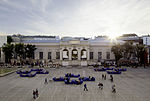Natural History Museum, Vienna

The Natural History Museum Vienna (German: Naturhistorisches Museum Wien) is a large natural history museum located in Vienna, Austria. It is one of the most important natural history museums worldwide. The NHM Vienna is one of the largest museums and non-university research institutions in Austria and an important center of excellence for all matters relating to natural sciences. The museum's 39 exhibition rooms cover 8,460 square meters and present more than 100,000 objects. It is home to 30 million objects available to more than 60 scientists and numerous guest researchers who carry out basic research in a wide range of topics related to human sciences, earth sciences, and life sciences.The Index Herbariorum code assigned to this museum is W and it is used when citing housed herbarium specimens.
Excerpt from the Wikipedia article Natural History Museum, Vienna (License: CC BY-SA 3.0, Authors, Images).Natural History Museum, Vienna
Burgring, Vienna Innere Stadt
Geographical coordinates (GPS) Address Phone number Website External links Nearby Places Show on map
Geographical coordinates (GPS)
| Latitude | Longitude |
|---|---|
| N 48.2052 ° | E 16.3599 ° |
Address
Naturhistorisches Museum
Burgring 7
1010 Vienna, Innere Stadt
Austria
Open on Google Maps










